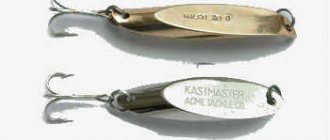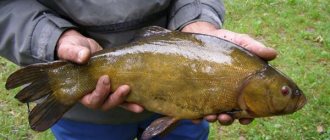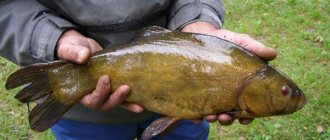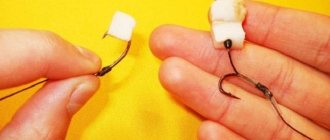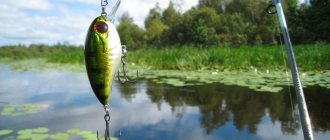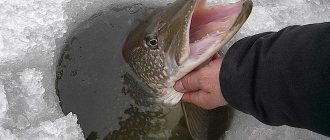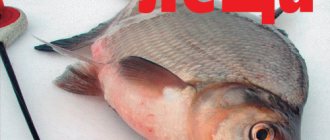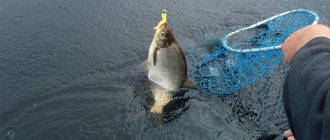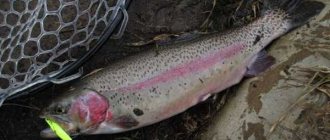Rotan is a somewhat unusual fish that can survive in almost any conditions. Even if she freezes in ice, in the spring she will be able to thaw and live as before. This predator can be caught in various bodies of water: river, lake, pond. However, as with any fishing, you should prepare for catching rotan.
Description of rotan fish
But first, let's understand what kind of fish this is. Rotan itself is a rather voracious predator; as a result, in almost any water area where it is located, it camouflages itself with the color of its environment. According to its color it can be:
- Absolutely black.
- A little greenish.
- Yellow.
- Brown.
- Gray.
The color of this predator largely depends on the shade of the water and the bottom. Many fishermen note that once in a fish tank, it can change color.
Typically the fish weighs about 500 grams. , body length is approximately 25 cm . The head of the predator is really large, with gills on the sides. Fish teeth The vision is excellent, with the help of which the fish sees perfectly underwater at a distance of up to 5 m. The fish has a large number of glands that secrete mucus, so the body of this fish is quite slippery.
Where does he live?
The homeland of this predator is the Far East. It was from there that it spread to other places. Today rotan can easily be found in the basins of large rivers: Volga, Dnieper, Don, etc. It is also common in standing reservoirs, where other types of predators do not live.
The most suitable bodies of water for catching rotan are the following: ponds and lakes. Because rotan is often the only predator there, so here it can reach really large sizes. Here he is comfortable and comfortable. However, if there is a pike or perch in a standing reservoir, then they have a significant impact on the rotan population.
- Number of aquatic vegetation. If you select a body of water for fishing for this particular predator, then you need to pay attention to aquatic vegetation. The predator feels best in places with rich vegetation. It is much more difficult to find rotan in clean water.
- Age of the water area. The older the body of water, the more large predators can be found there.
It should also be noted that at different times of the year, rotan behaves differently.
- Spring. In spring, rotan is quite active. When fishing for this predator in the spring, the main thing is to find a school of large individuals in a timely manner and select the most suitable bait for fishing.
- In the summer, the chance of a good catch of rotan is really high. But it is logical that you need to look for it in the thickets. The rotan swallows the bait quickly enough, so it is necessary to hook it in a timely manner, otherwise the hook simply will not be able to break through the mouth and the rotan will leave.
- At the beginning of autumn , it also hides in the thickets of grass; when the weather gets colder, it, like other types of fish, descends into the pits, where it sometimes remains in the winter.
- In winter, rotan also prefers to be in those areas where cold springs flow and streams flow. This is explained by the fact that fresh water brings oxygen, which, of course, the fish like.
Lifespan and spawning
Rotan has a fairly short life expectancy. Usually it is 6-7 years.
Rotan begins to spawn at 2-3 years of age. The spawning process itself occurs at a later time than in other fish, when they have already spawned and left the spawning grounds. Typically this happens in May-June . The fish spawns in portions, usually into aquatic plants. The eggs are guarded by the male. The emerging fry first feed on plankton and then move on to small invertebrates.
Nutrition
As noted earlier, rotan is a predator.
Adult representatives feed on leeches, small fish, fry, tadpoles, etc. In addition, there are even cases when this predator eats representatives of its own family. In small water areas, rotan can cause the destruction of other fish species. This is explained by the fact that these predators unite in schools and begin a real hunt for other species, devouring them until they are satisfied.
This fish prefers to eat for future use, so it is then inactive for a long time, digesting food at the bottom.
Due to the fact that rotan has a really wide and powerful mouth, it can swallow both 5 and 6-centimeter individuals without much difficulty. In addition to the fact that rotan feeds on fish living in the reservoir, it also loves insects from the surface of the water, and also finds all kinds of larvae in the soil.
Features of tactics
You can catch rotan with girders just for fun, placing a couple of pieces next to the fishing rods. If the goal is to catch as many more normal-sized fish as possible, then the installation of baits needs to be systematized. Such fishing will be laborious, but it will bring a heavier firebrand. In promising places, all the holes are drilled at once, and the flags (bet) are set empty in them one by one. Then we catch small rattans with a fishing rod, a little more in number than the set supply, and equip them. The bets can be equipped with bells - this will make it easier to record a bite in the desired hole amidst the running around. Bait for rotan is not always used, but its use can lure the rotan patriarch out of its writhing.
When it starts to bite, we simply go around all the gear, check it, put larger and larger live bait, until the size limit is revealed. Then we hang live bait on the hook slightly smaller than the size at which there are no longer any bites. This way we will catch only the largest individuals. This tactic requires constant running between the girders and catching live bait with a fishing rod. But it justifies itself - it is important to choose a certain rhythm. Instead of 300 finger-sized fish per cutlet, several dozen 200g are better suited. rotanov.
Subscribe to the channel:
My YouTube channel RYBAFAN on fishing:
We're OK
Is rotan harmful?
Many fishermen note that if rotan appears in a reservoir, the number of other fish decreases. And that's a fact. This is explained by the fact that this voracious predator eats fry and juvenile fish, eggs. This picture is more typical for small ponds.
But there is also the opposite situation. For example, in water areas where previously there were only crucian carp, fishermen often caught only small fish. When rotan appeared, larger individuals began to be caught. This is due to the fact that this predator began to eat crucian carp fry, and larger individuals began to have more food. However, in the long term, this can also lead to the extinction of a given species in a particular body of water.
We can talk about the benefits and harms of rotan for a really long time, but we need to accept the fact that this predator has become a full-fledged inhabitant of many reservoirs, which is quite actively caught. Many people fry rotans, smoke them, and make sprats.
Important ! Rotan can become a source of the common helminthic disease nanophyetosis! (Parasitic worms.)
How to avoid getting sick? Properly thermally process fish, do not violate the rules of storage and freezing.
II. Fishing with a spinner and a balancer.
Actively used throughout the winter. This method is in many ways similar to jig fishing. There are slight differences in the selection of gear:
• The fishing line used is thicker - 0.16-0.20 mm.
• The nod is hard, made of a metal plate or silicone, up to 7 cm long.
Bait characteristics:
1. Size. Perch spoons are used for vertical retrieves 2-3 cm long.
2. Color. Typically, spinners and balancers of gold or silver color are used. The best bait is considered to be the one whose lower half is covered with a light-emitting substance, and the upper half is painted gold.
3. Hook. Either soldered or movably mounted with a long forend. Lures equipped with a movable tee with an “eye” - a bright colored bead at the base of the hook - have proven themselves well.
Fishing technique
The game is as follows: the bait is thrown above the bottom and released into free fall. At the lowest point, be sure to pause for a few seconds. Swinging the bait at the bottom or tapping it on the ground can be effective.
As in the case of a jig, a predator rarely bites on a bare spoon - at least a small piece of bait should always be present on the hook. In this case, the firebrand can even grab spoons lying on the bottom.
In some cases, even bottom spinners are used - the front part of such a bait goes into the bottom soil, and the hook suspended in the tail, with its vibrations, attracts a predator prowling the bottom.
Photo of rotan fish
To open a photo in higher resolution, click on the image.
Peculiarities of rotan behavior
Rotan continues to spread from year to year, and its unpretentiousness to the habitat contributes to reproduction in conditions unsuitable for other fish. It follows that first of all, you need to make sure that rotan is present in a particular body of water.
The larger the lake or pond, the greater the likelihood of catching a trophy specimen. With a sufficient amount of food and small peaceful fish, which are potential prey for predators, rotan fish can gain weight of more than 0.5 kg with a height of over 35 cm. If there is no pike in the reservoir, then rotan, eating eggs and juveniles of peaceful fish, reduces their population.
Fishing for rotan
This predator is caught in many ways. The most common are the following:
- Float rod.
- Spinning.
- A fishing rod with a side or regular nod.
It is important to note that rotan is not caught using a bottom fishing rod. This is due to the fact that rotan is located in the coastal zone, where it can be easily reached with a float rod, and this fish bites most intensively on active bait.
Let's look at these types of fishing in more detail.
Fishing with a float rod
The correct choice of bait plays an important role in successful float fishing. Rotan bites well on:
- Worm.
- Maggot.
- Malkov.
- Leech.
- Snails.
This predator fishes best on a float rod before the ice sets in, namely in October and November. Its activity can be compared with the intensity of biting on first ice. The design of the float rod on rotan is identical to the Bolognese one, i.e. There is no need to demand special elegance and sophistication from the gear, because... Rotan is not difficult to catch without complex tricks.
Fishing technique
- First, the fishing depth is determined.
- This depth is selected on the fishing rod, because the hook should be located at the bottom; if you are fishing with live bait, then it should be above the bottom at a distance of 10-15 cm.
- Actually, now the tackle needs to be cast.
- While waiting for a bite, do not forget to twitch the rod from time to time so that the bait plays in some way, attracting the predator. If you are fishing with live bait, then you need to slightly move the bait.
- Rotana should be pruned in a timely manner. Determining this if you are catching this predator for the first time is not at all easy, because rotan can approach the bait, swallow it and simply suck it further. And if you hook ahead of time, you can simply pull the bait out of the fish’s mouth without allowing it to catch.
I. Fishing with a jig.
This method is one of the most popular. A jig is an artificial metal bait with a soldered hook. Can be used with or without an attachment.
Selection of gear
Choosing gear is not difficult - the small size of the predator allows you to use any fishing rod for winter fishing. Very often, fishermen use “balalaikas” with a nod. This rod has a number of advantages - it is light, comfortable, small in size, and already equipped with a small reel that acts as a handle.
The fishing line is ordinary monofilament, with a diameter of 0.08-0.12 mm. It is worth noting that rotan is not a shy fish and greedily grabs prey, not being afraid even of thick fishing line, so even monofilament with a thickness of 0.2 mm is suitable. Often a thick line is necessary - rotan is usually caught in thickets of underwater grass, where hooks are a standard occurrence. The nod is short made of lavsan or silicone tube. You can buy it in a store or make it yourself.
Characteristics of the bait
Features of jigs:
1. Form: – pellet; - crap; – oatmeal; - a drop; – goat. You can successfully use other models of jigs - rotan is quite voracious and grabs the bait without looking too closely at the shape.
2. Material. Fishing occurs at shallow depths, so tin and lead baits are suitable. If the fishing line is thick, then you should take heavy tungsten jigs, which allow you to quickly lower the equipment to the bottom.
3. Color. There is no specific coloration - fish preferences can change quickly. Light baits of white, gold and silver colors are considered the best.
size 4. Rotan is distinguished by a huge head - up to a third of the body length, and also a very large mouth, so it can easily swallow even a large jig. It is preferable to use medium and large baits with hooks of 4-5 sizes - at the discretion of the angler. The predator swallows small jigs very deeply, and then removing them is quite problematic. For the same reason, hooks should have a long shank.
Fishing technique
Playing with a jig is not particularly difficult. Most often, this is the bait touching the bottom, followed by a sharp rise of 20-30 cm and a pause, during which a bite follows. You can diversify the game by tapping the jig on the ground and oscillating. You should not twitch the bait too often and for a long time - the firebrand does not often attack a moving bait, preferring to grab stationary prey.
If the bite is bad, especially in the middle of nowhere, you should switch to a smooth game of tackle with long pauses or even fish with a stationary jig.
A rotan bites on a bare hook, but not often, preferring an additional animal bait. You can catch it with a reelless bait during the period of first ice, when the fish are very active and grab almost all baits indiscriminately. At this time, large specimens of rotan are often caught using a bare jig.
Side nod and winter fishing rod
Winter fishing rod with jig for perch and rotan.
We have combined these two types of gear due to the fact that they are very similar. More detailed article on winter fishing for rotan. Both here and here the same equipment and the same baits are used. The whole difference is that the fishing methods and the actual sizes of the rod differ.
The equipment of the nodding fishing rod in both cases is absolutely identical:
- Fishing rod.
- Nod.
- Fishing line.
- Spinner or jig.
- Bait.
The spinner or jig in this gear is used to visually attract rotan, and the bait itself forces the rotan to show itself and bite.
How to play?
The game itself is quite simple; you need to periodically pull the fishing rod, remembering to pause. Some fishermen in winter prefer to make several holes and walk from one to another, playing each one periodically.
Watch a video on catching rotan in the dead of winter on thick ice, youtube:
Fishing with live bait
If you decide to catch rotan with live bait, then the equipment is not particularly different from a standard fishing rod. It is equipped with the following elements:
- With a noticeable gatehouse;
- The standard line is about 0.2 mm.
- Sinker.
- Stopper.
- Matching hook.
The hook is placed on the baitfish's back and/or mouth and lowered into the hole. In this case, the depth should be selected in such a way that about 10-20 cm remains to the bottom. When catching rotan with live bait, you can catch a really large predator, although medium-sized predators are also caught with live bait.
Features of catching rotan
- This predator is liked by many anglers for its persistent and simple bite. He swallows the bait really deeply.
- In a reservoir it can be located in all layers , so when fishing you should select the most suitable depth.
- If the hooking was too early and the rotan broke, then you should not worry that it will go far. Often, if you lower the bait into the same place, the rotan will start biting again.
- This predator prefers quiet bodies of water, with virtually no current . If the reservoir does not freeze, then you can catch it throughout the whole year.
- It has been noted that large rotan prefers a “sandwich” rather than bait of the same type.
- In autumn and early winter, larger rotans prefer animal baits .
- He doesn’t pay much attention to the fishing line, so there’s no need to use too thin one.
- Rotan is very well caught in the presence of vegetation in the reservoir , because that's where he likes to hide.
- This predator usually bites where it stands. He waits for prey, and does not search for it throughout the entire body of water, like a perch.
- The most optimal time for catching rotan is April and May , when the reservoir is completely free of ice. The fact is that the fish strives to accumulate strength for spawning, so its gluttony is almost constant. And it is caught using completely different baits.
These are the most important features of a predator such as rotan, which should be taken into account in the process of preparing for fishing.
Winter fishing for rotan
For a long time now, winter fishing for rotan has been not just entertainment, but full-fledged fishing, especially in reservoirs where the population of this Far Eastern guest lives for a long time and there are individuals weighing up to a kilogram. The gastronomic qualities of rotan are excellent, but in order to catch it with cutlets, you need to try to find a decent size firebrand. An article about catching large rotan in winter.
If the bite is normal, then the firebrand sits on the hook one by one. This kind of fishing gets boring. Catching rotan on baits in winter is aimed at cutting off small fish and catching larger specimens. Rotan takes no worse on a rod than on a fishing rod. You just need to take into account some nuances associated with the greed of this predator. If you want to catch a firebrand of 100 grams or more, then the bait on the hook of the girder must be appropriate. If there are a large number of small firebrands in the reservoir, the main task in winter is to present the bait so that it has time to wait for a large predator before it is torn apart by the small ones.
Winter fishing gear
To catch firebrands, both active and passive fishing methods are used. You can use fishing rods of various designs for winter fishing, made at home or purchased. The main requirement for a fishing rod is an elastic whip. Rotan bites sharply and after hooking it strongly resists. The equipment must be reliable.
A suitable line diameter would be 0.14 or thicker. A smaller diameter may break when playing fish at shallow depths. In addition, a thick fishing line does not really alarm rotan. A reel with extra line will make you feel more comfortable.
Electrical tape is used to balance the gear. To successfully hunt for rotan on the first ice, use the method of active fishing with a balance beam. True, with this method you will have to run from one hole to another. You can’t do this type of fishing without balanced gear.
You should choose a fairly hard nod, preferably a spring type. This is due to the size of jigs, bait, as well as the frequency of play.
Rotan jigs are used in considerable sizes, so for correct play you need nods with the appropriate load-carrying capacity. The fishing rod should be light and elastic; such tackle significantly improves the animation of the bait.
Rotan in spring
After the ice begins to melt, rotan in the spring continues to remain in the “wintering” areas until the freeze-up completely disappears. These are depressions overgrown with algae and places with abundant dying vegetation. At the beginning of spring, increased activity is observed only in small rotan. On sunny days, flocks can be found throughout the ice-free water area of the reservoir.
As the water warms up, small fish and water insects “wakes up”. The largest rotans living in a particular body of water begin to move behind them. In the second half of spring, the predator is found everywhere. Before spawning, sexually mature large predators begin to eat. During this period, he reacts to everything that reminds him of his usual prey.
What is live bait and the benefits of using it
A baitfish is considered a small fish; by keeping it alive, it behaves naturally in the aquatic environment, which attracts the attention of a predator.
This bait is suitable for catching pike and perch, pike perch and other fish that prefer to feed on small representatives of their family; the advantages of its use include:
- high catchability due to full compliance with the behavior of fish under water;
- installing several gears, which helps increase the likelihood of catching a predator;
- a passive method of fishing, without the need to constantly cast spinning rods and gear.
Tips for a fisherman: What kind of braid is needed for catching pike - Let's take it step by step
A mandatory aspect of live bait fishing is the purchase of high-quality bait that can remain active in the water for a long time.
«>
«>
«>
«>
«>
«>
«>
«>
«>
Even a wounded and weakly active fish can become a good bait, because it emits a smell that attracts predators and is clearly visible in the muddy water of reservoirs.
When using several girders, it is better to place them at a distance of 8-10 meters from each other.
The cord on the summer version of the tackle must be hung either on an elastic branch above the place (most often these are willow branches) in which you plan to fish, or on a rod inserted into the ground.
An underwater winter trap is installed using a straight stick directly in the hole.
The surface-type model, used in winter, holds well on the hole itself with the help of a base.
Most often, predatory fish species (namely, they are caught on a girder) live:
- In recesses, closer to the river bed;
- Sometimes near springs or active underwater springs;
- In the pits of reservoirs or where there is uneven terrain with sharp changes;
- Near underwater objects such as large fallen trees, reeds or other vegetation;
And the fastest, simplest, but less humane methods in terms of preserving live bait are through both lips, through the nostril, just above the head, etc.
When the bait on the hook behaves realistically - as all fish in the water should, then the pike will not feel the catch and will attack this bait faster than another artificial one, for example.
How to bait live bait so that it stays alive longer than all the living ones?
Autumn time, when predators are in full swing - to gain fat before the cold and hungry winter days.
Today is the time for spinners and those who hunt for toothy fish.
Live bait is the most catchy and attractive bait for pike. It doesn’t even compare to the coolest artificial baits coated with flavors.
Options for how to put live bait on a hook so that it is durable?
The most humane method and the one where our live bait lasts longer when fishing for pike is the method of baiting through the gills.
Thread the leash through the gills and carefully attach a winding ring or swivel with a clasp to it. And the hook to the ring or swivel is a double or tee.
And I consider another working method to be correct - the method of attaching live bait through the back, under the upper fin, between the ribs and fin is more reliable in preserving the fish on the pike - this way, the fish, just like with the method through the gills, remains alive longer.
Another method that experienced fishermen often use when fishing with live bait is to pass a leader through the anus of the bait into the mouth.
There are other ways. For example, using a rubber band. We wind the elastic band at the base of the tail and hook the hook to it.
And the fastest, simplest, but less humane methods in terms of preserving live bait are through both lips, through the nostril, just above the head, etc.
Here's a video on how to place live bait on a hook correctly:
And how do you put live bait on the hook - which method do you use more so that the bait remains alive as long as possible, behaves in the water as a fish should, and so that the pike does not notice the deception and attacks in an instant.
Did you like the article? Subscribe to the channel to stay up to date with the most interesting materials
Perhaps, as a person who is passionate about fishing, I idealize the behavior of fish, but so far my observations indicate this. I myself use two proven methods that have not yet failed.
Fishing gear
Rotan can be caught using a spinner or a winter fishing rod with a jig. It should be noted that it is better not to use small hooks and devices on him, because he swallows them deeply and getting the hooks out will be problematic.
Each fisherman has his own recipe for catching rotan. When going fishing for the first time, it is better to have several fishing rods with different equipment. You need to use a strong fishing line, because with the fish you can pull out a bunch of grass, or even a twig.
Rotan needs meat, so bloodworms, worms and even beef, beloved by all fish, will do. Some fishermen use chicken skin, lard, or a piece of freshly caught chicken. It is preferable to have various fish “goodies” with you in case something goes wrong.
At the beginning of winter, rotans bite all day long. In the morning and in the evening, large individuals come to feed, so you may be lucky to pull them out too.
Rotan in summer
At the beginning of summer, rotan spawns. It can last until the second half of June, and during this period, targeted fishing for rotan by amateur fishermen is usually not practiced.
After spawning, the predator is highly active during daylight hours. Experience shows that the best bite is observed at dawn and sunset. But this is not dogma. It is known that even in the sunshine you can expect a rotan bite.
Ways to place live bait on a baitfish hook
Among the common, or classic, methods are:
- Under the dorsal fin.
- Under the gills with exit through the mouth.
- For the lips.
- For the nostrils.
- At the caudal fin.
None of them passes without injury to the live bait, so you should not hope that the fish will be able to attract the attention of a predator for a long time. Especially in the summer, when the water temperature is quite high (especially in stagnant shallow reservoirs) and live bait quickly “falls asleep” compared to the winter period.
The tricks of fishermen to do without piercing live bait with the help of rubber bands and rope fastenings reduce the number of effective bites. I convinced myself when I experimented and attached the hook to the tail fin with an elastic band. The pike, probably during the first attack, simply knocked down the bait.
As for the type of hook used, the choice should be made based on the size of the baitfish and the method of hooking.
And now directly how to attach live bait to the girder. As a test subject, I took a medium-sized perch caught yesterday using a “witch” jig without attachments.
Under the dorsal fin of live bait
The most popular way. Of course, it is better and more convenient to use special tees, in which one hook is smaller in size compared to the other two in the solder, but the standard one is not bad either.
Fastening is carried out by piercing with one tee hook the area under the dorsal fin of the baitfish at the highest and fleshiest point.
Care is required here. Having damaged the spine, the baitfish will quickly fall asleep.
The method is relevant for installing a girder on a stagnant body of water with little current. With this installation, the fish remains active for quite a long time. But a lot depends on the ambient temperature. In summer, live bait can “dead” in a couple of hours, in autumn and winter it remains alive for 24 hours.
Tips for fisherman: Real fishing, how to catch a damn pike - What is the difference, pros and cons
Impaled through the gills
A reliable and effective method of attachment, but the live bait remains mobile for a noticeably shorter time than the previous option. Of course, the problem is injury to the fish’s respiratory organ—the gills.
To reduce the impact of the leash on the gill rakers, fishermen use polymer materials instead of metal - fluorocarbon or thick monofilament folded in half. To each his own, but I can confidently say that there is nothing more reliable than a metal leash against the teeth of a pike on the girders.
I came across a modified version of the nozzle through the gills, even tried it once, but immediately abandoned it due to ineffectiveness.
The treble hook pierces the muscles on the fish's back and is attached to a leader threaded through the mouth and gills.
In my opinion, in this case, the pike has a greater chance of simply pricking itself on the hook (even if it is a double). And, examining the live bait under water, I noticed completely unnatural movements. Maybe with soft Panton leader material everything will change, but the string definitely does not allow the live bait to move forward.
By the way, the lucky chance of pulling the hook out of your finger increases.
For the nostrils and lips
You should attach live bait by the nostrils and lips when fishing with single hooks, and this involves installing a girdle on perch and medium-sized pike - grass with a small fish.
A frequent case for fishing with a float rod in local areas. Carefully lower it out the window among the grass or snags and wait for a bite.
At the caudal fin
Similar fastening as under the dorsal fin. The live bait does not have any difficulty in its movements; it is active. However, I noticed that only those fish are detected that immediately take the whole bait into their mouth. If the pike initially grabbed the “barrel”, then after a sharp movement to the side it easily rips off the bait.
So. Of the five available classical methods for attaching live bait to a girder, I use only two in practice when hunting for pike - baiting under the dorsal fin and through the gills.
Time has shown that they are the simplest and most effective when fishing with various baits on still bodies of water and with little current.
If there is no bite, after freeing the fish from the hook and leash, the live bait can be reused or it is better to release it into its native element.

